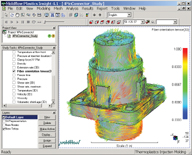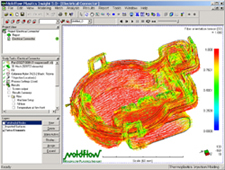November 1, 2004
By Peter K. Kennedy
When considering the properties of plastics, most design engineers think aboutproperties required for structural analysis such as modulus, Poisson’s ratio,and perhaps thermal coefficient of expansion. However, the properties of a polymercannot be properly discussed without considering the processing history of themethod used to form the product. In this article we consider the state of theart in relating plastic properties to the process of injection molding.
Properties and Processing

Predicted shear or rigidity modulus on a thick and solid plastic part using Moldflow’s3D tetrahedral mesh solution. The shear modulus refers to the change producedby a tangential stress. It provides a measure of how stiff the material is. Thisresult shows the shear strain applied in the XY direction, coinciding with thefiber orientation direction. Image courtesy of Moldflow Corp.
Plastic or polymer is comprised of very long molecules with aspect ratios around20,000. If we imagine a polymer molecule to be 0.125 inches in diameter, its lengthwould be around 200 feet. In their normal state, these molecules are tangled togetherlike a bowl of spaghetti. Many properties of polymers stem from this structure.When hot, the molecules are mobile, enabling the material to flow and hence tobe formed into products. When cold, the molecules lock in place and the materialappears solid. In addition to this basic behavior, a polymer, depending on itsmolecular geometry and chemical makeup, may crystallize on cooling. Unlike manyother materials, some polymers do not crystallize completely. Rather they arecomposites of crystalline and amorphous regions, and are called semi-crystallinepolymers. The orientation of these regions as well as the morphology of the materialdetermines its final properties. However, property prediction is difficult becausevarying process conditions produce different morphologies and hence, properties.
 The situation is further complicated by the addition of reinforcement. Frequentlyshort glass fibers are added to polymers to increase their modulus. These fibershave thermo-mechanical properties that are very different from those of the polymer,and the properties of the composite material are determined by the final orientationof the glass fibers. This, in turn, is determined by processing history.
The situation is further complicated by the addition of reinforcement. Frequentlyshort glass fibers are added to polymers to increase their modulus. These fibershave thermo-mechanical properties that are very different from those of the polymer,and the properties of the composite material are determined by the final orientationof the glass fibers. This, in turn, is determined by processing history.
Top left: Predicted fiber orientation tensor.
In shear flow, the fibers tend to align in the shear direction. However, in areasof diverging flow, it is possible for fibers to align transverse to the flow directiondue to extensional forces. Near the injection point of an injection-molded part,a complex distribution of properties arises through the thickness. Near the moldwall, where shear forces are high, the fibers align in the flow direction. Atthe centerline of the part however, there is no shear, and the extensional stressassociated with expansion of the flow front aligns the fibers transverse to flow.This results in a modulus gradient through the thickness. With respect to theflow direction, modulus is high at the wall, decreases toward the center, andincreases as you approach the opposite wall. Although the gradient is continuouslyvarying, some people refer to this as a three-layer “wall-core-wall” structure.The moduli of the wall and core regions are very different. Moreover, the relevantthicknesses of the wall and core regions are determined by processing effects.Consequently, in reality, we have variable moduli at every point within the molding.Structural analysis of plastic components needs to account for this variation.
 Oddly, there has been more progress in predicting properties of glass fiber filledplastics than in the case of neat polymers. This is because the glass fiber propertiesdominate those of the polymer. If one can calculate their orientation, propertiescan be predicted.
Oddly, there has been more progress in predicting properties of glass fiber filledplastics than in the case of neat polymers. This is because the glass fiber propertiesdominate those of the polymer. If one can calculate their orientation, propertiescan be predicted.
The fiber orientation tensor result shows the orientation tensor (degree of orientation)in each tetrahedral element at the end of the injection molding process. The fiberorientation tensor result shows the probability of fiber alignment in the specifiedprinciple direction.
Simulation and Analysis
Prediction of polymer properties from knowledge of processing history has beena long-term goal of material scientists and remains a vibrant research area today.Much of the sequel is still under development but elements of it will soon beavailable in commercial products.
For unfilled amorphous materials, considerable progress has been made in predictionof long-term mechanical properties. Nevertheless most current research is focusedon unfilled semi-crystalline materials. These materials generally have betterproperties for engineering applications and so are more likely to be subject tostructural analysis.
In order to link properties to processing, a simulation of the process is required.Injection molding simulation has been an important tool to the design engineersince its introduction in the early 1980s. Today’s approach is more sophisticatedhowever and entails two steps. First, a simulation of molding is carried out todetermine the morphology of the material and then this morphology is used to predictthe properties of the (composite) material consisting of amorphous and semi-crystallineregions.
For the simulation, it is necessary to use viscoelastic analysis to correctlydetermine the extension and orientation of polymer molecules during molding. Knowledgeof their configuration allows us to determine crystallization of the material,accounting for the effects of flow, temperature, and rate of change of temperature.Results of such analysis yield the orientation of the semicrystalline regions,their size, and shape. This morphological information can then be used to predictproperties for the material after processing using micromechanical models or directfinite element analysis. Moreover, since the approach used is viscoelastic, itis possible to continue calculation of properties into the future. This allowscomputation of long-term effects such as creep, post-molding crystallization,or warping due to exposure to high temperatures after molding. Development inthis area is currently devoted to prediction of modulus, impact strength, andthermal coefficients of expansion from the calculated morphology.
Turning now to fiber-filled polymers, the approach is very different. In thiscase the kinematics of the fluid flow in molding is determined by a flow analysis.These results are used to determine the orientation of the glass fibers. The orientationis determined in three dimensions at every point within the part. Once the materialis solidified the fibers are locked in place. Using the properties of the fibersand the matrix polymer, we use micromechanics to determine properties such asmodulo, coefficient of expansion, and Poisson’s ratio. Interfacing this data toa structural analysis permits an anisotropic analysis in a layered shell or 3Delement. Material properties vary through the thickness and account for variationin tensile and flexural modulus.
More Efficient Designs
Plastics are complex materials with properties that depend on processing history.For the case of unfilled semi-crystalline materials, current research is focusedon determining the morphology using the processing history and then in turn determiningthe desired properties from this information.
For fiber-filled materials, the technology is more advanced. Today, it is possibleto determine thermomechanical properties of short fiber reinforced plastics, takinginto account such factors as processing conditions, gating locations, and thedegree of fiber loading in the material. Results from these analyses provide datafor interfacing to many structural analysis packages and enable the variationof properties to be accounted for.
Continued improvements in process simulation will provide better understandingof material properties and enable more accurate structural analysis of plasticcomponents. The future for structural analysis will involve coupling to processsimulation. The resulting capabilities will provide more accurate analysis andlead to more efficient designs that take advantage of the material variationsthat are due to processing.
Peter K. Kennedy is the chief technology officer at Moldflow Corp. of Wayland, MA. E-mail commentsabout this article to [email protected].
Images courtesy of Moldflow Corp.
Product Information
Moldflow Corp.
moldflow.com
Subscribe to our FREE magazine, FREE email newsletters or both!
About the Author
DE’s editors contribute news and new product announcements to Digital Engineering.
Press releases may be sent to them via [email protected].






